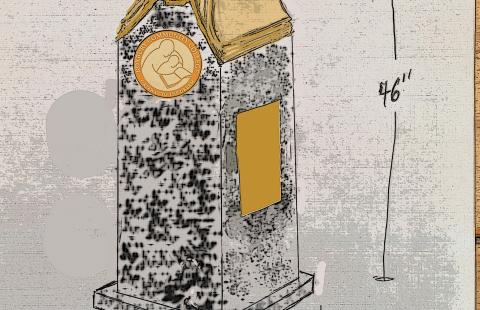What were the specific goals of this creative economy project? Describe the community development challenge or opportunity that your project was designed to address:
The trail goals are multiple: one is to provide a vehicle for exploring, appreciating, and sharing with the neighborhood and the broader community the rich cultural heritage of Roxbury/Dorchester. Second is to provide a lively, flexible curation of the diverse resources allowing visitors to generate a "filtered" trail offering for specific interests or focus such as " historic architecture", "civil rights", "young school children", or "agricultural history or colonial history". Third, the planners who are mostly "elders" see the trail and its pacemaker artworks as a vehicle for building positive self actualization of young users through career discovery and artwork making observations, potential uploading of short videos showing experiential use of the trail onto the proposed interactive phone app.
If the goals change over time, please describe how:
This complex project with as many as 125 potential sites was first conceived 20 years ago with Robert Hector, a local history buff, and the Greater Grove Hall Main Streets program. A $200,000 Browne Fund grant was earmarked for the project, but after two false starts with two differing artists that moved away from Boston, this new collaboration with a broader base of networked support is achieving lift off. Importantly, the planning team recognizes the need for an ongoing planning and maintenance effort for the trail as wells a business plan to support the proposed phone app and its technical maintenance as programs and platforms change over time. Hence we are also seeking corporate in kind or ongoing financial support for that technology. The small NEFA Photography grant is one of our first successful steps in supporting that approach.
Who was involved in this project and what did they do? (be sure to include the partners from outside of the creative sector and how local voices were included):
Sr. Virginia Morrison is the Ex. Director of the Grove Hall NDC and is the Chair of the Trail Team
Robert Hector, of the Greater Grove Hall Main Streets is our history buff and historic memory who first conceived of the trail.
Ed Gaskin is the Ex. Director of the Greater Grove Hall Main Streets
Joyce Stanley is the Ex. Director of the Dudley Sq. Main Streets
Barry Gaither is the Ex. Director of Museum of the National Center of Afro American Artists
Pat Loheed, FASLA, Phil Loheed, AIA, and Sarah Howard, LEED, Earthos Institute are pro bono support to the Trail Project as Land. Arch., Urban Designer, and Planner respectively.
Tristan Govignon is Sculptor/Artist for Phase One pacemaker markers for fall 2015 completion.
How does this project relate to a larger community development strategy?
The trail project leverages potential future projects and improvements including a potential STEAM school on Cheney Street across the street from the Grove Hall NDC offices, the potential DPW City improvements for design and handicapped access for the public parking lot adjacent, the completed this fall, sidewalk and street tree replacement improvements on Blue Hill Avenue and Washington St. Three additional markers are planned for Phase Two in Grove Hall. Phases Three through Five will include additional markers in the Dudley Square area, prioritized markers in the trail loops, including Franklin Park and the Zoo. An over arching priority will be the business and marketing plan and the development of the trail phone app. We have made friends with visual and video artists at Emerson College who have developed an interactive phone app for use with Boston's Urban Wilds, portions of that may be a model for our work and a potential collaboration may develop for this trail effort.
What projects or places, if any, inspired your approach to this creative economy project?
We are looking at the "Starry Night bike trail "Inspired by the famed Dutch painter's "Starry Night" work, artist Daan Roosegaarde teamed up with Heijmans Infrastructure to create the 1-kilometer-long Van Gogh-Roosegaarde cycle path, which opened inthe city of Eindhoven on November 13. The path is illuminated by thousands of twinkling stones that feature
glow-in-the-dark technology and solar-powered LED lights." We are investigating this technology for illumination of the ground plane near markers as well as LED solar lighting and bollards. The Emerson College interactive phone app creative process has also inspired us as well and the economic success of the Arlington, MA Minuteman Bike Trail which is familiar to us because of our work with the Arlington on the Town Hall Gardens 1.4 million dollar phased restoration and work on feasibility studies for their Spy Pond park which is adjacent to the bikeway. Last during an arts residency at the Catwalk Art Institute in Catskill NY we became familiar with the Hudson River Painters Trail. We have been invited back for an April 2015 ten day arts residency to study and develop a comparison of that trail, the Roxbury Trail and one or two other precedents, by Purcell Palmer, founder of the Catwalk Art Institute. Additionally, Phil Loheed and Sarah Howard are working with a paid team of Boston Architectural College Gateway interns and the property owners of the Motor Mart to develop a feasibility study for a Steam School at that site. If plans come to fruition, this educational center would have physical making and creative jobs exploration facilities and classes that would feed into the full build out of the trail concept. Last, we hope to secure City of Boston Youth Fund internships for five to six creative Boston High School Students to explore creative design careers, using the trail markers, fabrication, and installation for 25 hr. a week for six weeks in July and August 2015. Pat Loheed was successfully able to do this for two summers through the Boston Architectural College and we hope to reprise this project through the Grove Hall CDC using college mentors to lead the effort.
